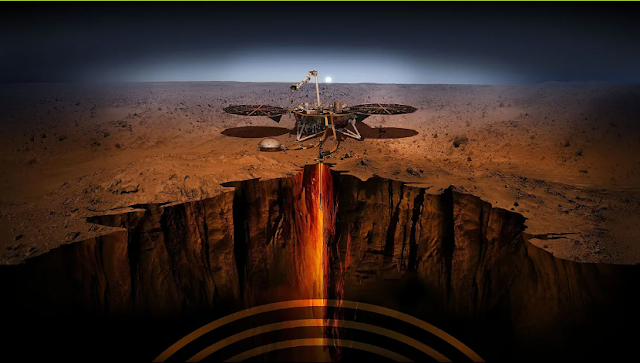 |
| Artist impression of InSight at work. Image Credit: NASA/JPL-Caltech |
NASA’s InSight has sent its final communication
home. We knew the end was coming for this incredible lander but it's still sad
to say goodbye. The robotic explorer revolutionized our knowledge of the Red
Planet, allowing for a detailed understanding of the interior of Mars. After
almost 1,500 Martian days of work, more than double what was originally
planned, InSight has turned off its instruments and its mission has ended.
Before we discuss the incredible achievements of
this mission and the fantastic work of the engineers and scientists behind it,
join us in cursing the Martian dust for once again ending one of the robots we
sent there.
InSight's solar panels accumulated dust over time,
and without dust devils around the lander to blow the dust off them, the power
they could gain continued to drop. Earlier this year it became clear InSight
could not clear them and all instruments but the seismometers were stopped to
conserve energy. Recently, even that instrument could only stay on for a
limited time every day.
NASA declared the mission over because InSight has
missed two consecutive communications sessions. The lander talks to us via the
five spacecraft in the Mars Relay Network. Its silence is telling,
demonstrating that it is no longer operational. NASA’s Deep Space Network will
keep listening just in case for a little while, but there won’t be any special
efforts to re-establish communications. The only thing that can save InSight is
the wind which could clean the solar panels, but this appears to be extremely
unlikely at this stage.
It is no hyperbole to state just how much InSight
has expanded our understanding of the Red Planet. The data collected by the
lander has informed us about the interior structure of Mars and provided new
understanding into the planet’s extinct magnetic field and the weather in
Elysium Planitia, where the InSight landed on November 26, 2018
“Finally, we can see Mars as a planet with layers,
with different thicknesses, compositions,” explained mission principal
investigator Bruce Banerdt of NASA’s Jet Propulsion Laboratory, in a statement.
“We’re starting to really tease out the details. Now it’s not just this enigma;
it’s actually a living, breathing planet.”
And, of course, InSight will be remembered for the
discovery of marsquakes in 2019. Since then it has recorded over 1,000
marsquakes and even recorded the tremors produced by meteors hitting the
planet. The most powerful quake recorded was in May 2022, which released five
times more than any previously recorded, lasting for more than four hours.
“The seismometer aboard the InSight lander has
recorded thousands of marsquakes but never one this large, and it took over
three years after landing to record it,” Professor Caroline Beghein, said of
the major quake. “This quake generated different kinds of waves, including two
types of waves trapped near the surface. Only one of those two has been
observed on Mars before, after two impact events, never during a marsquake.”
The data collected is invaluable and will provide
scientific discoveries for decades to come. InSight, you have more than earned
your rest.




0 Comments